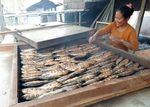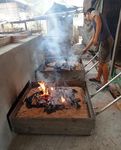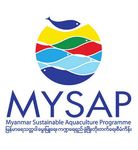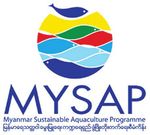Improved fish smoker delivers a superior product - MIMU
←
→
Page content transcription
If your browser does not render page correctly, please read the page content below
Success Story
Improved fish smoker delivers
a superior product
Myanmar Sustainable Aquaculture Programme
The Chinbridge Institute conducted a stacked value chain analysis of smoked rohu from Kale Township,
Sagaing Region of Myanmar1 under a consultancy contract from March to June 2020, for the inland component
of the Myanmar Sustainable Aquaculture Programme (MYSAP), which was funded by the European Union
and the German Federal Ministry for Economic Cooperation and Development (BMZ).
The stacked value chain analysis (SVCA) approach used qualitative and quantitative methodologies, and
questionnaires adapted from the Dakshin Foundation, the Dried Fish Matters programme and the Royal
Tropical Institute (KIT), the Netherlands.
The key findings of the SVCA were:
• Seven rohu smokers in Kale Township, that were operated by either ethnic Chin or Mizo, processed an
estimated 1,605 viss (2,616 kg) of fresh rohu (MMK 3,200 per viss2) into 401 viss (654 kg) of finished
smoked rohu daily.
• 90% of the smoked rohu was exported to Mizoram State, India because of a price premium, with the
smoked rohu industry of Kale Township worth MMK 1.75 billion per year (€ 1.24 million per year).
• The current locally developed fish smokers were inefficient in their use of fuel (wood and sawdust),
poorly designed from a health and safety point of view of the staff operating them and there were
concerns about the consistent quality of the products produced, its shelf life and basic food safety and
hygiene practices that required improvement.
To address the above issues, MYSAP conducted field activities to pilot improvements of the existing traditional
fish smoking technology. Bandara Rotawewa, an international consultant from Sri Lanka, was engaged to
introduce the FAO-Thiaroye Processing Technique (FTT) improved smokers3 by modifying the design to fit
the local availability of construction materials and to virtually oversee the construction of 2 improved smokers.
1
A Stacked Value Chain Analysis Study of Smoked Rohu from Kale Township, Sagaing Region, Myanmar (worldfishcenter.org)
2
A viss = 1.63 kg. Each viss has 100 tical (16.3 g).
3
FAO-Thiaroye processing technique: towards adopting improved fish smoking systems in the context of benefits, trade-offs
andpolicy implications from selected developing countriesThe supported 2 fish processors were Daw Vuli, from Pyin Khone Lay Village and U Lala from Nat Gyi Kone Village, Kale Township, in the Sagaing Region of Myanmar, near the border with India. Daw Vuli and U Lala were 2 of the first smokers in Kale Township and were selected for MYSAP support by their peers as they were both seen as innovative and motivated to share what they learned with others. Daw Vuli, was particularly interested in differentiating her smoked rohu product from that of others and wanted to add value to her smoking process. At the time of the consultancy Da Vuli was processing 46,000 viss (74,980 kg) of fresh raw rohu and producing 11,500 viss (18,745 kg) of smoked fish and earning MMK 33,682,000 (US$ 21,556) annually from her rohu smoking business by directly exporting her produce to the Mizoram state of India at MMK 16,000 per viss. U Lala was producing 8,250 viss (13,448 kg) of smoked rohu and was earning MMK 11,920,000 (US$ 7,629) annually by selling his produce to a middle trader. U Lala was making MKK 1,445 profit per viss of smoked rohu sold, while Da Vuli was making MMK 2,929 per viss of smoked rohu sold, or twice as much profit per viss than U Lala. Despite weak internet services at the time, Yu Maung, the MYSAP Inland Field Coordinator for the Sagaing Region who operated from the office of the NGO Ar Yone Oo, in Kale Township used his mobile phone at the smoking facility to invite Bandara, in Sri Lanka, into a free Viber Messenger international video call, together with Khaing Kyaw, the MYSAP Inland’s Field Manager who translated from English to Myanmar language as Bandara mentored Daw Vuli and U Lala through the process of operating the FTT improved smokers, giving tips and specific instructions on how to take fish samples at different stages of the smoking process. Test operation of the smokers was conducted under the virtual supervision of the international consultant in Pyin Khone Lay Village with Daw Vuli and in Nay Gyi Kong Village, with U Lala, and the rohu Indian carp (Labeo rohita) used in the testing of the smokers was funded by MYSAP, because it was uncertain whether the final product could be sold. For sensory tests, fish were prepared and smoked on the same day for both the traditional and the FTT improved smokers to allow direct comparison. The rohu were hand graded into 3 different size categories, i.e. small, medium and large. For each size category of fish, 6 fish were individually marked with a piece of aluminium foil and numbered 1 to 6 using a permanent marker pen to allow individual fish identification. The 6 sampled fish for each size category were then weighed at different stages during the smoking process i.e. i) fresh on arrival, ii) after gutting, iii) after smoking, and later iv) after oven drying at 100 Celsius for 7 hours. Blind taste sensory evaluation testing was conducted in late April 2021 by randomly selecting 20 people (10 ♀ and 10 ♂) to assess seven different product properties being i) colour, ii) smell/odour, iii) appearance, iv) saltiness, v) texture, vi) taste/flavour and vii) general acceptability and scoring each on a scale of 1 to 5, with 1 being the lowest score and 5 being the highest possible score.
The key findings from this MYSAP funded pilot activity were extremely promising.
• The processing capacity of the pilot FTT‘s was 49.0-61.3 viss (80-100 kg) per batch and the capacity
could be further increased by making and stacking additional wooden framed smoker racks on top of the
smoking kilns;
• The smoking time was reduced from 12 – 14 hours for the traditional smoking method to 7 hours using
the improved FTT smoker;
• The FTT smoker used only one-third the amount of fuelwood and sawdust per weight of smoked fish
produced and therefore produces less greenhouse gas emissions;
• Operators and family members working with the FTT smoker were less exposed to smoke, which may
reduce the likelihood of respiratory infections;
• The FTT smoker required less handling and turning of the smoking fish and was more ergonomic and
easier to operate than the current traditional smoker that required a lot of back-bending work;
• The moisture content for the FTT smoker was more consistent across all 3 size grades of smoked fish and
it produced a more consistent quality of product than the traditional smoker;
• The moisture content from the FTT smoker ranged between 5.5% - 14%, 15% - 21% and 21% - 24% for
small, medium and large size grades of rohu;
• Buyers preferred the FTT smoked fish because it had an attractive golden colour and looked better than
the darker traditionally smoked fish;
• The overall mean taste panel score across the six sensory parameters (excluding saltiness) for the
traditionally smoked rohu was 20.6, compared to 25.5 per test person for smoked rohu from the improved
FTT, indicating that the smoked product from the improved FTT smoker was preferable to the traditionally
smoked rohu marketed in Kale Township, Sagaing Region, Myanmar. The sensory parameters with the
biggest difference were taste/flavour for which the traditionally smoked fish recieved an average score
of 3.25 compared to 4.45 for the FTT smoked fish, and overall acceptability for which the traditionally
smoked fish received an average score of 3.7 compared to 4.8 for the FTT smoked fish. Most taste panel
members found the level of salt adequate and suitable. Texture was rated lowest for both the traditional
and FTT smoked fish indicating the a softer texture was preferred. However a softer product would have
greater moisture content and would likely spoil under the current transport and storage system, which is
at ambient tropical temperatures without any temperature control;
• The weight loss for both the traditionally and FTT smoked fish on gutting, and on smoking and drying,
and the yield of the smoked product ranged between 5.5% - 8.5%, 66% - 71% and 23% - 29% respectively,
which was normal; and,
• Daw Vuli, on her own initiative, diversified her smoking product output and now uses the MYSAP
supported FTT improved smoker at the weekends to produce and profitably sell smoked pork.
The cost of the construction materials for building the FTT improved smoker in Myanmar was MMK 1,093,750
(US$ 7034). Despite the improved product quality and consistency from the FTT smoker, this has not as yet
resulted in higher sales price for the smoked rohu. However the savings in fuel wood and sawdust costs alone
will repay the investment cost for the FTT improved smoker construction materials in 3 years for Daw Vuli
and in 4 years for U Lala.
In addition to fuel wood and sawdust cost savings, savings may be made on labour because the processing
time is nearly halved and while someone has to oversee the traditional smoker continuously in case of fire
outbreaks, with the FTT smoker this is not necessary and workers have more free time and can engage in other
activities, like cleaning and packing, etc.
4
The exchange rate in January 2021 was MMK 1,315 = US$ 1.The conditions under which the pilot smoker activity and the consultancy were conducted did not allow a
full scale scientific direct comparison between the FTT smokers and the traditional smokers. Further study is
therefore required to assess the impact of the FTT improved smoker on:
1) The shelf life of the smoked fish;
2) Food safety of the smoked product, including reduced levels of polycyclic aromatic hydrocarbons
(PAH’s);
3) Nutritional quality of the smoked product;
4) Production capacity of the FTT smoker with different numbers of smoking racks above the kilns;
5) Improvements to meet local consumer’s preferences and opportunities to diversify product types and
add product value;
6) The operating profits of the smoker unit; and,
7) Capacity support for the fish smokers on marketing techniques and building product brands.
Outputs from this MYSAP funded consultancy input and pilot activity in addition to the construction of the
2 FTT improved smokers, were Myanmar and English language guide documents entitled:
1) Guide for the operation and testing of an FTT improved smoker (links56);
2) Guide for the construction an FTT improved smoker in Myanmar (links78); and,
Additionally the MYSAP supported FTT improved smoker activity has proven that when travel and face-to-
face visits are not possible, virtual mentoring and guidance can be provided, even when internet connectivity
is weak, using platforms like Viber.
5
Guide for the construction of an FTT smoker in Myanmar (worldfishcenter.org)
6
Guide for the construction of an FTT smoker in Myanmar (Burmese version) (worldfishcenter.org)
7
FTT smoker operation and testing protocol guidelines (worldfishcenter.org)
8
FTT smoker operation and testing protocol guidelines (Burmese version) (worldfishcenter.org)
inlandmysap@cgiar.orgYou can also read



























































